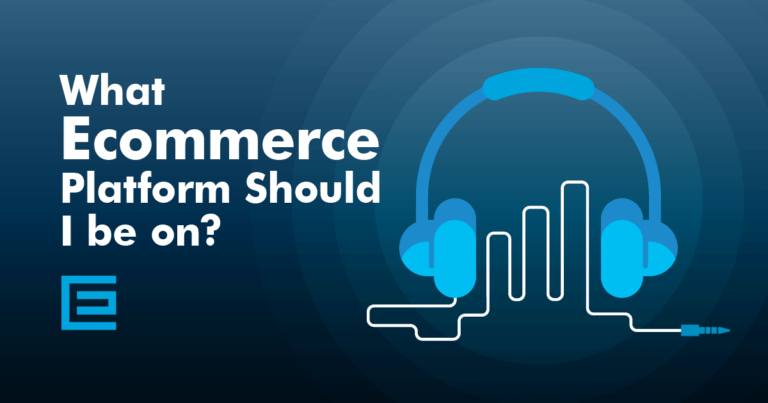On June 20, 2020, Magento 1 will reach the end of its life.
If your ecommerce business is currently running on Magento 1 and you haven’t upgraded to Magento 2 yet, it’s time to decide whether you should migrate to Magento 2 or switch to a new platform completely. Most Magento migrations will take three to nine months and, if you are working with a good Magento developer, will come at a hefty price.
Chances are, you’ve been on the Magento platform for a long time and have invested a large amount of your budget into it. It seems logical to move to Magento 2 if your team is used to the platform and you don’t want to lose your initial investment.
The truth is, migrating or upgrading to Magento 2 is the same thing as moving to a new platform like Shopify, Shopify Plus or WooCommerce.
The truth is, migrating or upgrading to Magento 2 is the same thing as moving to a new platform like Shopify, Shopify Plus or WooCommerce.
Magento 2 is actually a total rewrite of Magento 1, so upgrading to Magento 2 is the same amount of time and effort as moving to another platform. Cost on the other hand, as well as development time can be vastly different.
Some things to consider:
- Upgrading to Magento 2 creates as many problems as it solves
- Magento is not the e-commerce leader it used to be as commerce platforms like WooCommerce and Shopify have evolved and grown up
- Moving to a new platform is a great way to drive even better conversions with your store
- WooCommerce and Shopify are much easier and less time consuming for your team to manage without knowing how to code
Recent Shopify Improvements
Shopify has made some major enhancements in the last year. For one, with Shopify’s new fulfillment network merchants will be able to utilize an advanced nation-wide fulfillment network that rivals Amazon.
Shopify now offers many easy to use services such as:
- automated 3D imaging
- cross-brand upsells
- product personalization
- customer discount programs
- special user level pricing for wholesale customers
- multiple language and currency support
- excellent administrator User Interface
Shopify Myths
Now, you are probably thinking, “This isn’t what my Magento developer tells me. Who should I believe?” Here are a few myths your Magento developer might give you to upgrade to Magento 2:
Myth No. 1: Compared to Magento, Shopify is much less flexible
What is your goal? Complex doesn’t have to mean complicated coding. You can have complex features in your Shopify store, just as you can with a Magento store. You can build a site from the ground up, or heavily customize a theme, for less development hours and still come out with a fantastic product with amazing user experience and familiarity amongst users. The goal is not only to create a beautiful store, but to make it easy for customers to purchase and find your products, and also easy for your team to update, change prices, remove, and add products.
Also, with shopify there are a few things to keep in mind. First, Multi-channel sales mean that when your products are setup, you can push collections or individual products to over 20 channels like google shopping, Facebook Store, Amazon and Etsy.
Second, Metafields. Metafields allow developers and designers to customize pages, collections, and products to accommodate special design elements.
Third, Variants let you have complete control over how you present your products, and can be customized to go way beyond the default limit of 100 variants per product.
Here are a few examples that debunk the myth that Shopify websites are less flexible and all look the same:
For more Shopify Success Stories, check out their page here: https://www.shopify.com/success-stories (don’t forget to filter by Niche so you can find relevant examples within your industry).
Myth No. 2: Shopify is a hosted solution, so it’s less secure.
Shopify is likely the most secure network next to AWS (Amazon Web Services). There are huge demands on the Shopify cloud. And Shopify actually hires “white hat hackers” to find any vulnerabilities so that they can push out fixes to their huge network of commerce stores. You never have to worry about updating or migrating. The Shopify team is constantly detecting and rejecting attacks. With Magento, your host is responsible, and is likely much less effective or proactive about your website security.
Myth No. 3: Shopify makes it difficult to integrate with third-party software
This just isn’t true. Shopify has as many integrations available as Magento, and it’s not complicated. It would be impossible to list them all, but some examples are:
- HubSpot CRM
- Spocket for Drop Shipping
- Free Shipping Bar
- Plugin SEO
- KIT (to manage facebook and instagram ads)
- Bundle Upsell
- Wishlist Plus
- ReferralCandy
- One Click Social Login
And thousands more! If you can think of it, there is likely a Shopify app that can handle it.
Myth No. 4: Shopify Isn’t Scalable
Scaling your store is probably one of the easiest things Shopify has to offer. You will hardly have to do anything to go from 500 orders a month to 50,000 orders or more a month in a few minutes because they make it so simple.
With Magento not only will your store be offline while the development work is being performed but it will take hours of time and money to level up like that.
Myth No. 5: Shopify is bad for SEO (Search Engine Optimization)
As with any website, you need to do some work in order to rank well in search engines like Google. You or your agency partner will need to make sure you are using proper title tags, h1 tags, ALT tags on your product images and of course the legwork for your off-site SEO as well. Some things that will improve your SEO (on any store, not just Shopify) are:
- Remove duplicate content
- Optimize your product images
- Add sitemap.xml to your Google Search Console
- Integrate with Google Analytics
- Technical SEO
- 301 redirects from your old product pages
- Fresh content using the Shopify blog feature
- Enable Shopify product reviews
Want a professional opinion on whether you should upgrade to Magento 2 or replatform to Shopify? Talk to a digital strategist to see what makes the best sense for you. Get started by giving us a call at 919-341-8901 or by sending us a message!
Tags: Ecommerce • Magento • Our Favorites • Shopify













